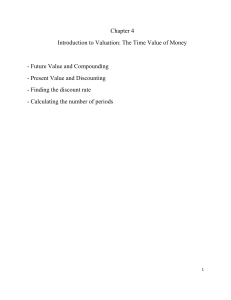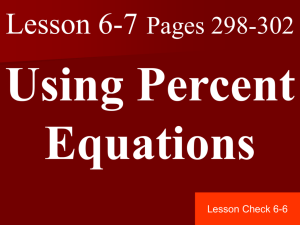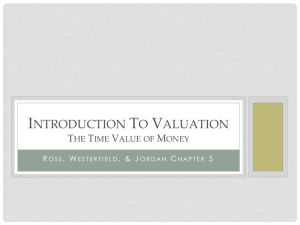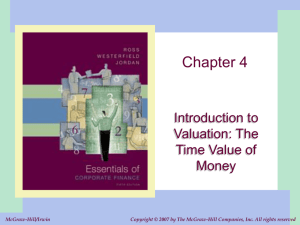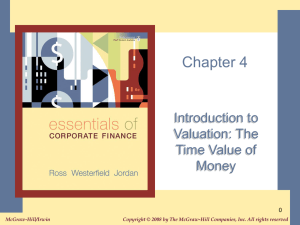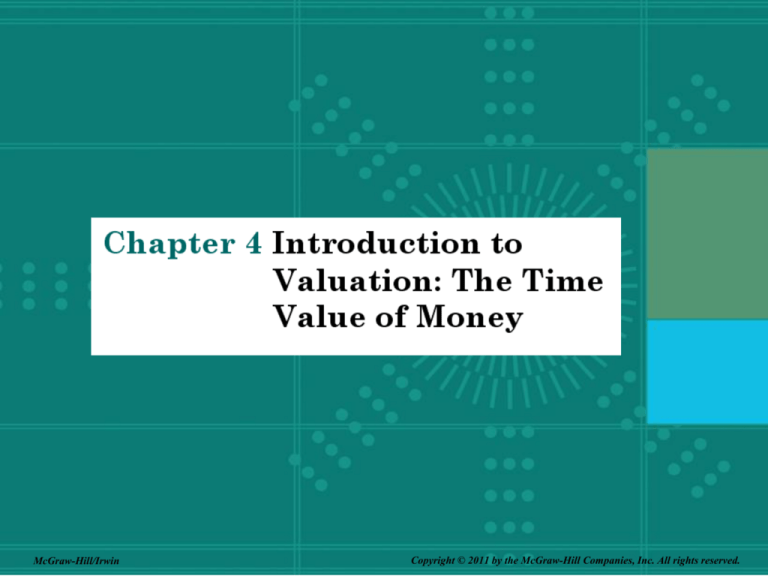
4-1
McGraw-Hill/Irwin
Copyright © 2011 by the McGraw-Hill Companies, Inc. All rights reserved.
Key Concepts and Skills
• Be able to compute:
– The future value of an investment made today
– The present value of cash to be received at some
future date
– The return on an investment
– The number of periods that equates a present value
and a future value given an interest rate
• Be able to solve time value of money problems
using:
– Formulas
– A financial calculator
– A spreadsheet
4-2
Chapter Outline
4.1 Future Value and Compounding
4.2 Present Value and Discounting
4.3 More on Present and Future Values
Solving for:
Implied interest rate
Number of periods
4-3
Basic Definitions
• Present Value
(PV)
– The current value of future cash flows
discounted at the appropriate discount rate
– Value at t=0 on a time line
• Future Value
(FV)
– The amount an investment is worth after one
or more periods.
– “Later” money on a time line
4-4
Basic Definitions
• Interest rate (r)
– Discount rate
– Cost of capital
– Opportunity cost of capital
– Required return
– Terminology depends on usage
4-5
Time Line of Cash Flows
•Tick marks at ends of periods
• Time 0 is today;
• Time 1 is the end of Period 1
0
1
2
3
CF1
CF2
CF3
r%
CF0
+CF = Cash INFLOW -CF = Cash OUTFLOW
PMT = Constant CF
4-6
Time Line for a $100 Lump Sum
due at the End of Year 2.
0
r%
1
2 Year
100
4-7
Future Values: General Formula
FV = PV(1 + r)t
FV = future value
PV = present value
r = period interest rate, expressed
as a decimal
t = number of periods
• Future value interest factor = (1 + r)t
Note: “yx” key on your calculator
4-8
Future Values – Example 1
Suppose you invest $100 for one year
at 10% per year.
What is the future value in one year?
– Interest = 100(.10) = 10
– Value in one year
= Principal + interest
= 100 + 10 = 110
– Future Value (FV)
= 100(1 + .10) = 110
4-9
Future Values – Example 1
Suppose you leave the money in for another
year. How much will you have two years
from now?
FV = 100(1.10)(1.10)
= 100(1.10)2 = 121.00
4-10
Effects of Compounding
• Simple interest
– Interest earned only on the original
principal
• Compound interest
– Interest earned on principal and on
interest received
– “Interest on interest” – interest earned
on reinvestment of previous interest
payments
Return 4-11
to Quiz
Effects of Compounding
• Consider the previous example
– FV w/simple interest
= 100 + 10 + 10 = 120
– FV w/compound interest
=100(1.10)2 = 121.00
– The extra 1.00 comes from the interest
of .10(10) = 1.00 earned on the first
interest payment
4-12
Texas Instruments BA-II Plus
0 = future value
.b = present value
- = period interest rate (r)
, = number of periods
One of these MUST
be negative
,
-
.
/
0
4-13
Texas Instruments BA-II Plus
- = period interest rate (r)
[ must equal 1 for the - to be the period
rate ([ = 1 = default on new BAII+)
Interest is entered as a percent, not a decimal
• 5% interest = “5”, not “.05”
/ = 0 for this chapter only!
• Clear the registers before each problem
&^
Or reenter each field
4-14
Texas Instruments BA-II Plus
• Set number of decimal places to display
– Press & key,
– Press | key (above “.”),
– Enter desired decimal places (e.g., 4).
– Press &U to set the displayed choice.
4-15
Texas Instruments BA-II Plus
• Be sure “payment per period” is set to “1”
– Press & key,
– Press [ (above -),
– Enter “1”,
– Press !
– Press &U
4-16
TI BAII+: Set Time Value
Parameters
• Be sure calculator is set for cash flows at the
END of each period
• To set END (for cash flows occurring at the end
of the period),
– Press & key,
– Press ] (above /).
• This is a toggle switch. The default is END.
• To change to BEGIN, hit &V (above !) to go back and
forth.
– Press &U to set the displayed choice.
4-17
Future Values – Example 2
• Suppose you invest the $100 from the previous
example for 5 years. How much would you
have?
Formula Solution:
FV
=PV(1+r)t
=100(1.10)5
=100(1.6105)
=161.05
Keystrokes: 1.1 ; 5 N <100 N 161.0510
4-18
Table 4.1
4-19
Figure 4.1
4-20
Texas Instruments BA-II Plus
• To calculate FV: 10% 5 years PV=$100
Key Entry
Display
&^
0.00
5,
5.00
10 10.00
100 S.
-100.00
0/
0.00
% 0
161.05
4-21
Excel Spreadsheet Functions
• Excel TVM functions:
=FV(rate,nper,pmt,pv)
=PV(rate,nper,pmt,fv)
=RATE(nper,pmt,pv,fv)
=NPER(rate,pmt,pv,fv)
• Use the formula icon (ƒx) when you can’t
remember the exact formula
• Click on the Excel icon to open a
spreadsheet containing four different
examples.
4-22
Future Values – Example 3
Suppose you had a relative deposit $10 at 5.5%
interest 200 years ago. How much would the
investment be worth today?
Formula Solution:
FV = PV(1+r)t
= 10(1.055)200
=10(44718.984)
=447,189.84
Calculator Solution
200
,
5.5
10
S.
0
/
%0
= 447,189.84
Excel Solution: =FV(Rate,Nper,Pmt,PV)
=FV(0.055,200,0,-10) = 447189.84
NOTE: Rate = decimal
4-23
Future Value: General Growth
Formula
Suppose your company expects to increase unit
sales of widgets by 15% per year for the next 5
years. If you currently sell 3 million widgets in
one year, how many widgets do you expect to
sell in 5 years?
Formula Solution:
FV
=PV(1+r)t
=3(1.15)5
=3(2.0114)
=6.0341 million
Calculator Solution
5 ,
15 3 .
0 /
%0
= -6.0341
Excel Solution: =FV(Rate,Nper,Pmt,PV)
=FV(0.15,5,0,3) = -6.0341
4-24
Future Value:
Important Relationship I
For a given interest rate:
– The longer the time period,
– The higher the future value
FV = PV(1 + r)t
For a given r, as t increases, FV increases
4-25
Future Value
Important Relationship II
For a given time period:
– The higher the interest rate,
– The larger the future value
FV = PV(1 + r)t
For a given t, as r increases, FV increases
4-26
Figure 4.2
4-27
Quick Quiz: Part 1
• What is the difference between simple
interest and compound interest? (Slide 4.11)
• Suppose you have $500 to invest and
you believe that you can earn 8% per
year over the next 15 years. (QQ1 Solution)
– How much would you have at the end of 15
years using compound interest?
– How much would you have using simple
interest?
4-28
Present Values
• The current value of future cash flows
discounted at the appropriate discount rate
• Value at t=0 on a time line
• Answers the questions:
– How much do I have to invest today to have
some amount in the future?
– What is the current value of an amount to be
received in the future?
4-29
Present Values
• Present Value = the current value of
an amount to be received in the future
• Why is it worth less than face value?
– Opportunity cost
– Risk & Uncertainty
Discount Rate = ƒ (time, risk)
4-30
Time Line of Cash Flows
•Tick marks at ends of periods
• Time 0 is today;
• Time 1 is the end of Period 1
0
1
2
3
CF1
CF2
CF3
r%
CF0
+CF = Cash INFLOW -CF = Cash OUTFLOW
PMT = Constant CF
4-31
Present Values
FV = PV(1 + r)t
• Rearrange to solve for PV
PV = FV / (1+r)t
PV = FV(1+r)-t
• “Discounting” = finding the present value
of one or more future amounts.
Return
to Quiz 4-32
What’s the PV of $100 due in 3
Years if r = 10%?
Finding PVs is discounting, and it’s
the reverse of compounding.
0
1
2
3
10%
PV = ?
100
Formula: PV = FV(1+r)-t = 100(1.10)-3 = $75.13
Calculator: 3,
75.13
10-
0/
1000
Excel: =PV(.10,3,0,100) = -75.13
%. = 4-33
Present Value: Example 1
Single Period
Suppose you need $10,000 in one year for the down
payment on a new car. If you can earn 7% annually,
how much do you need to invest today?
Formula Solution:
PV
=FV(1+r)-t
=10,000(1.07)-1
=10,000/1.07
=9,345.79
Calculator Solution
1
,
7
0
/
10000 0
%. = -9345.79
Excel Solution: =PV(Rate,Nper,Pmt,FV)
=PV(0.07,1,0,10000) = -9345.79
4-34
Present Values: Example 2
Multi-Periods
You want to begin saving for your daughter’s college
education and you estimate that she will need
$150,000 in 17 years. If you feel confident that you
can earn 8% per year, how much do you need to
invest today?
Formula Solution:
PV
=FV(1+r)-t
=150,000(1.08)-17
=150,000/(1.08)17
=-40,540.34
Calculator Solution:
17
,
8
0
/
150000 0
%. = -40540.34
Excel Solution: =PV(Rate,Nper,Pmt,FV)
=PV(0.08,17,0,150000) = -40540.34
4-35
Present Values: Example 3
Multi-Periods
Your parents set up a trust fund for you 10 years
ago that is now worth $19,671.51. If the fund
earned 7% per year, how much did your parents
invest?
Formula Solution:
PV
=FV(1+r)-t
=19,671.51(1.07)-10
=19.671.51/(1.07)10
=-10,000
Calculator Solution:
10
,
7
0
/
19671.51 0
%. = -10000
Excel Solution: =PV(Rate,Nper,Pmt,FV)
=PV(0.07,10,0,19671.51) = -10000
4-36
Present Value:
Important Relationship I
For a given interest rate:
– The longer the time period,
– The lower the present value
FV
PV
t
(1 r )
For a given r, as t increases, PV decreases
4-37
Present Value:
Important Relationship I
What is the present value of $500 to be
received in 5 years? 10 years? The
discount rate is 10%
0
-310.46
-192.77
PV?
r=10%
5
10
500
PV?
500
5 yrs: PV = 500/(1.10)5 = -310.46
(1.10)5 =1.6105
10 yrs: PV = 500/(1.10)10= -192.77
(1.10)10 = 2.5937
4-38
Present Value
Important Relationship II
For a given time period:
– The higher the interest rate,
– The smaller the present value
FV
PV
t
(1 r )
For a given t, as r increases, PV decreases
4-39
Present Value:
Important Relationship II
What is the present value of $500 received
in 5 years if the interest rate is 10%? 15%?
Rate = 10%
Calculator Solution:
5
,
10
0
/
500
0
%. = -310.46
Rate = 15%
Calculator Solution:
5
,
15
0
/
500
0
%. = -248.59
4-40
Figure 4.3
4-41
Quick Quiz: Part 2
• What is the relationship between present
value and future value? (Slide 4.32)
• Suppose you need $15,000 in 3 years. If
you can earn 6% annually, how much do
you need to invest today? (Solution)
• If you could invest the money at 8%,
would you have to invest more or less
than at 6%? How much? (Solution)
4-42
The Basic PV Equation - Refresher
PV = FV / (1 + r)t
There are four parts to this equation
– PV, FV, r and t
– Know any three, solve for the fourth
• Be sure and remember the sign convention
+CF = Cash INFLOW -CF = Cash OUTFLOW
4-43
Discount Rate
• To find the implied interest rate,
rearrange the basic PV equation and
solve for r:
FV = PV(1 + r)t
r = (FV / PV)1/t – 1
• If using formulas with a calculator, make
use of both the yx and the 1/x keys
4-44
Discount Rate – Example 1
You are looking at an investment that will pay
$1200 in 5 years if you invest $1000 today.
What is the implied rate of interest?
– Formula:
r = (1200 / 1000)1/5 – 1 = .03714 = 3.714%
– Calculator – the sign convention matters!!!
5
,
1000 S. (you pay $1,000 today)
0
/
1200 0
(you receive $1,200 in 5 years)
% - = 3.714%
– Excel: =RATE(5,0,-1000,1200) = 0.03714
4-45
Discount Rate – Example 2
Suppose you are offered an investment that will
allow you to double your money in 6 years. You
have $10,000 to invest. What is the implied rate of
interest?
6
,
10000
S.
0
/
20000
0
%= 12.25%
Excel: =RATE(6,0,-10000,20000) = 0.1225
4-46
Discount Rate – Example 3
Suppose you have a 1-year old son and you want
to provide $75,000 in 17 years towards his college
education. You currently have $5,000 to invest.
What interest rate must you earn to have the
$75,000 when you need it?
Calculator:
17 ,;5000 S.;0 /; 75000 0 %- = 17.27%
Excel: =RATE(17,0,-5000,75000) = 0.1727
4-47
Quick Quiz: Part 3
• What are some situations in which you
might want to compute the implied interest
rate?
• Suppose you are offered the following
investment choices:
– You can invest $500 today and receive $600 in
5 years. The investment is considered low risk.
– You can invest the $500 in a bank account
paying 4% annually.
– What is the implied interest rate for the first
choice and which investment should you
choose? (Solution)
4-48
Finding the Number of Periods
• Start with basic equation and solve for t:
FV = PV(1 + r)t
FV
ln
PV
t
ln(1 r )
Calculator: %,
Excel:
=NPER(Rate, Pmt, PV, FV)
4-49
Number of Periods – Example
You want to purchase a new car and you are
willing to pay $20,000. If you can invest at 10%
per year and you currently have $15,000, how
long will it be before you have enough money to
pay cash for the car?
Calculator Solution:
10 -; 15000 S .;20000 0;
%, = 3.02 years
Excel: =NPER(0.10,0,-15000,20000)= 3.02
4-50
Number of Periods – Example
FV
ln
PV
t
ln(1 r )
• Formula Solution:
– FV/PV = 20,000/15,000 = 1.333
– ln(1.333) = 0.2877
– ln(1.10) = 0.0953
– t = 0.2877/0.0953 = 3.0189
4-51
Quick Quiz: Part 4
• When might you want to compute the
number of periods?
• Suppose you want to buy some new
furniture for your family room. You
currently have $500 and the furniture
you want costs $600. If you can earn
6%, how long will you have to wait if
you don’t add any additional money?
(Solution)
4-52
Example: Work the Web
• Many financial calculators are available
online
• Click on the web surfer to go to the
present value portion of the
Moneychimp web site and work the
following example:
– You need $40,000 in 15 years. If you can
earn 9.8% interest, how much do you need
to invest today?
– You should get $9,841
4-53
Table 4.4
4-54
Quick Quiz 1 Solution
• Invest $500 at 8% per year over 15 years.
– How much would you have at the end of 15
years using compound interest?
• 15 , 8 500 S.
1586.08
• 500(1.08)15 = 1586.08
• =FV(.08, 15, 0, -500)
0/
%0
– How much would you have using simple
interest?
• 500 + 15(500)(.08) = 1,100
Return
to Quiz 4-55
Quick Quiz 2 Solution
• You need $15,000 in 3 years. You can earn
6% annually, how much do you need to
invest today?
3 ,
615000 0
%. -12594.29
0/
PV= 15000/(1.06)3 = 15000/(1.191016) =
= 15000 x 0.83962) = 12594.29
=PV(.06, 3, 0, 15000)
Return
to Quiz
4-56
Quick Quiz 2 Solution
• You need $15,000 in 3 years. If you could invest
the money at 8%, would you have to invest more
or less than at 6%? How much?
3 ,
8%. -11907.48
15000 0
0/
PV= 15000/(1.08)3 = 15000/(1.125971)
= 15000 x (0.79383) = 11907.48
=PV(.08, 3, 0, 15000)
Difference = $686.81
Return
to Quiz 4-57
Quick Quiz 3 Solution
Investment choices:
– Invest $500 today and receive $600 in 5 years. The
investment is considered low risk.
– Invest the $500 in a bank account paying 4%
annually.
– What is the implied interest rate for the first choice
and which investment should you choose?
5 ,
3.714%
500 S.
0/
600 0
%-
r = (600/500)1/5 - 1 = 3.714%
=RATE(5, 0, -500, 600)
The bank account pays a higher rate.
Return
to Quiz 4-58
Quick Quiz 4 Solution
Suppose you want to buy some new furniture for
Your family room. You currently have $500 and
the furniture you want costs $600. If you can earn
6%, how long will you have to wait if you don’t
add any additional money?
6 500 S.
3.13 years
0/
600 0
%,
t = ln(600/500) / ln(1.06) = 3.13 years
=NPER(.06, 0, -500, 600)
Return
to Quiz 4-59
Chapter 4
END



